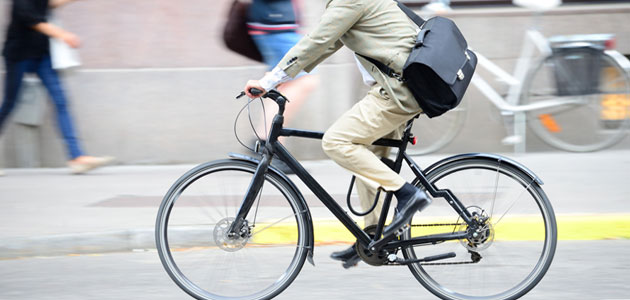Keep safe while commuting by bike: 5 useful tips for new bike commuters
 It’s really important to keep safe while commuting by bike so when fellow rider/writer Amanda Wilks of Mountain Bike Reviewed contacted me and asked if she could contribute an article I was keen to publish it.
It’s really important to keep safe while commuting by bike so when fellow rider/writer Amanda Wilks of Mountain Bike Reviewed contacted me and asked if she could contribute an article I was keen to publish it.
Over to Amanda…..
If you love to cycle and care about the environment, choosing to ride to work can help you both improve your fitness level and reduce harmful emissions. However, for the uninitiated, commuting to work can present some problems – maybe you aren’t sure how to make sure you’re seen by vehicles, or maybe you want to avoid showing up to work sweaty. Here are five tips for bike commuters that will help you transition smoothly to riding to work.
Be sure your bike is safe and fits correctly
It may sound like common sense, but too many people get out on the road without checking to make sure their bike is safe and that it fits them correctly. Before you start riding to work, weigh adequately whether your bike is in good working order – you don’t want something to break while you’re riding next to rush-hour traffic. It’s also a good idea to get a bike fit. A good bike fit can ensure that you’re riding with good posture. Riding over time with a poorly-fitted bike also can predispose you to injuries and pains, so it’s best to get a bike fitted early on.
If your bike does not fit you correctly, it also may make you more likely to experience a fall or accident. For instance, if the reach on your bike is too long, it may be difficult to reach the brakes. This is why mountain bikes designed for women generally have shorter reaches and are more ergonomic, making them safer and more comfortable for many women to ride. Regardless of the bike type you have, getting a professional fit after purchase will improve your safety as well as your comfort when riding.
Choose bright lights
Choose very bright headlights and taillights for your bike. If you are commuting in the early morning or after dark, these lights will help drivers notice you. Many taillights also come with several pre-programmed flashing settings for added visibility.
The brightness of a bike light is measured in lumens. Brighter lights will generally be in the range of 500-600 lumens, while less bright lights in the 100-200 lumen range are also available. If you’re commuting at night, a brighter light is generally worth the expense because it will more reliably protect you from vehicles.
Shower at work if you can
Many bike commuters are dedicated to cycling, and they will often ride even in bad weather. This may become especially important if you have a long commute in the summer months and don’t want to sweat through your work clothes.
To minimize the amount of gear you need to carry on your bike, you can leave body wash and shampoo at your workplace to use when you arrive. If your workplace has no shower facilities, it’s a good idea to at least have a change of clothes in case you sweat excessively or find that road debris gets on your riding clothes. Leaving your work shoes at the office will also cut down on what you need to carry on your bike.
Pack a spare inner tube and kit
When you commute to work, the last thing you want is a bicycle tyre that goes flat. Because flat tyres are always a risk when you ride, it’s vital that you know how to change an inner tube. It’s also important that you have a tyre change kit. Generally, these include a spare tube, tyre levers, and a way to inflate the new tube. Usually, CO2 is used because it comes in small, portable containers, but you can also bring a small bike pump.
Many tyre repair kits are compact and can be mounted right under your bike’s saddle, making them easy to take along. If you prefer a bike pump, many smaller pumps can be mounted directly to your bicycle frame.
Ride safely and follow traffic rules
Use hand signals, make eye contact with drivers when needed, and following the rules of the road. Usually, bicycles are legally considered vehicles, but it is very important to read and understand cycling laws in your home town before you get on the road. Cycling on the road can be dangerous, but you will be less likely to be hit by a car if you ride predictably and obey road laws.
For many bike commuters, riding to work quickly becomes a way of life. Frequently, a cyclist who rides to work will say that they do so even if it is freezing, raining, snowing, or excessively hot. While it’s important to be mindful of potential dangers and to ensure that you are adequately prepared, riding to work is an excellent choice for those who are health-minded, environmentally conscious, or both.

